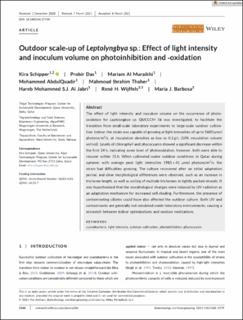| dc.contributor.author | Schipper, Kira | |
| dc.contributor.author | Das, Probir | |
| dc.contributor.author | Al Muraikhi, Mariam | |
| dc.contributor.author | AbdulQuadir, Mohammed | |
| dc.contributor.author | Thaher, Mahmoud Ibrahim | |
| dc.contributor.author | Al Jabri, Hareb Mohammed S.J. | |
| dc.contributor.author | Wijffels, Rene Hubertus | |
| dc.contributor.author | Barbosa, Maria J. | |
| dc.date.accessioned | 2022-07-13T13:33:43Z | |
| dc.date.available | 2022-07-13T13:33:43Z | |
| dc.date.created | 2021-08-09T17:10:50Z | |
| dc.date.issued | 2021 | |
| dc.identifier.citation | Schipper, K., Das, P., Al Muraikhi, M., AbdulQuadir, M., Thaher, M. I., Al Jabri, H. M. S. J., Wijffels, R. H., & Barbosa, M. J. (2021). Outdoor scale‐up of Leptolyngbya sp.: Effect of light intensity and inoculum volume on photoinhibition and oxidation. Biotechnology and Bioengineering. 118(6), 2368–2379. doi: | en_US |
| dc.identifier.issn | 1097-0290 | |
| dc.identifier.uri | https://hdl.handle.net/11250/3005095 | |
| dc.description.abstract | The effect of light intensity and inoculum volume on the occurrence of photooxidation for Leptolyngbya sp. QUCCCM 56 was investigated, to facilitate the transition from small-scale laboratory experiments to large-scale outdoor cultivation. Indoor, the strain was capable of growing at light intensities of up to 5600 µmol photons/m2/s, at inoculation densities as low as 0.1 g/L (10% inoculation volume vol/vol). Levels of chlorophyll and phycocyanin showed a significant decrease within the first 24 h, indicating some level of photooxidation, however, both were able to recover within 72 h. When cultivated under outdoor conditions in Qatar during summer, with average peak light intensities 1981 ± 41 μmol photons/m2/s, the strain had difficulties growing. The culture recovered after an initial adaptation period, and clear morphological differences were observed, such as an increase in trichome length, as well as coiling of multiple trichomes in tightly packed strands. It was hypothesized that the morphological changes were induced by UV-radiation as an adaptation mechanism for increased self-shading. Furthermore, the presence of contaminating ciliates could have also affected the outdoor culture. Both UV and contaminants are generally not simulated under laboratory environments, causing a mismatch between indoor optimizations and outdoor realizations. | en_US |
| dc.language.iso | eng | en_US |
| dc.publisher | Wiley | en_US |
| dc.rights | Navngivelse-Ikkekommersiell 4.0 Internasjonal | * |
| dc.rights.uri | http://creativecommons.org/licenses/by-nc/4.0/deed.no | * |
| dc.title | Outdoor scale-up of Leptolyngbya sp. : Effect of light intensity and inoculum volume on photoinhibition and -oxidation | en_US |
| dc.type | Peer reviewed | en_US |
| dc.type | Journal article | en_US |
| dc.description.version | publishedVersion | en_US |
| dc.rights.holder | © 2021 The Authors | en_US |
| dc.subject.nsi | VDP::Matematikk og Naturvitenskap: 400::Basale biofag: 470::Generell mikrobiologi: 472 | en_US |
| dc.subject.nsi | VDP::Teknologi: 500::Bioteknologi: 590 | en_US |
| dc.subject.nsi | VDP::Matematikk og Naturvitenskap: 400::Basale biofag: 470::Biofysikk: 477 | en_US |
| dc.source.pagenumber | 2368-2379 | en_US |
| dc.source.volume | 118 | en_US |
| dc.source.journal | Biotechnology and Bioengineering | en_US |
| dc.source.issue | 6 | en_US |
| dc.identifier.doi | 10.1002/bit.27750 | |
| dc.identifier.cristin | 1924847 | |
| dc.relation.project | QDVC: QUEX‐CASQDVC‐ 14/15‐7 | en_US |

